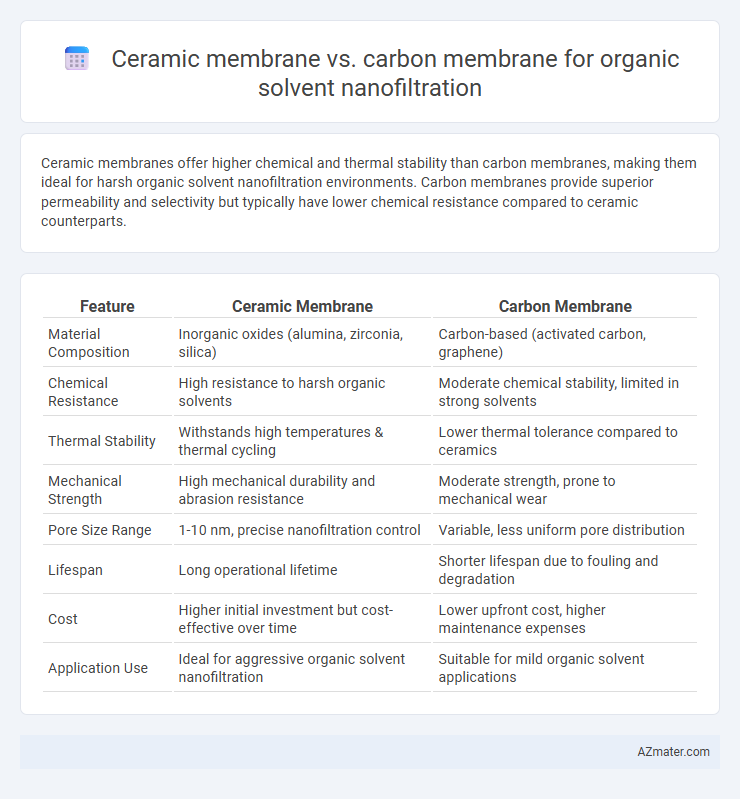Ceramic membranes offer higher chemical and thermal stability than carbon membranes, making them ideal for harsh organic solvent nanofiltration environments. Carbon membranes provide superior permeability and selectivity but typically have lower chemical resistance compared to ceramic counterparts.
Table of Comparison
| Feature | Ceramic Membrane | Carbon Membrane |
|---|---|---|
| Material Composition | Inorganic oxides (alumina, zirconia, silica) | Carbon-based (activated carbon, graphene) |
| Chemical Resistance | High resistance to harsh organic solvents | Moderate chemical stability, limited in strong solvents |
| Thermal Stability | Withstands high temperatures & thermal cycling | Lower thermal tolerance compared to ceramics |
| Mechanical Strength | High mechanical durability and abrasion resistance | Moderate strength, prone to mechanical wear |
| Pore Size Range | 1-10 nm, precise nanofiltration control | Variable, less uniform pore distribution |
| Lifespan | Long operational lifetime | Shorter lifespan due to fouling and degradation |
| Cost | Higher initial investment but cost-effective over time | Lower upfront cost, higher maintenance expenses |
| Application Use | Ideal for aggressive organic solvent nanofiltration | Suitable for mild organic solvent applications |
Introduction to Organic Solvent Nanofiltration Technologies
Organic solvent nanofiltration (OSN) utilizes selective membranes to separate molecules based on size and chemical affinity in harsh solvent environments. Ceramic membranes offer high thermal and chemical stability, making them ideal for aggressive solvents and harsh operating conditions in OSN applications. Carbon membranes provide excellent permeability and selectivity with strong solvent resistance, enabling efficient separation of organic molecules while maintaining durability in various solvent systems.
Overview of Ceramic Membranes in OSN Applications
Ceramic membranes in organic solvent nanofiltration (OSN) offer superior chemical stability and thermal resistance compared to carbon membranes, enabling efficient separation of organic compounds under harsh conditions. Their rigid structure and tunable pore size distribution provide high selectivity and permeability for solvents like ethanol, toluene, and dimethylformamide. Ceramic membranes demonstrate excellent durability and long operational lifespan, making them ideal for industrial OSN applications that require consistent performance and solvent compatibility.
Understanding Carbon Membranes for Organic Solvent Filtration
Carbon membranes exhibit exceptional chemical resistance and thermal stability, making them highly effective for organic solvent nanofiltration applications. Their microporous structure enables selective separation of organic molecules while maintaining high permeate flux and solvent compatibility. Compared to ceramic membranes, carbon membranes offer enhanced flexibility and tunable surface properties, optimizing performance in aggressive solvent environments.
Material Composition and Structural Differences
Ceramic membranes for organic solvent nanofiltration are primarily composed of inorganic materials such as alumina, zirconia, or titania, providing high chemical stability and thermal resistance. Carbon membranes consist of carbon-based materials like graphene or carbon molecular sieves, offering excellent hydrophobicity and selective permeability. Structurally, ceramic membranes feature rigid, porous frameworks with uniform pore sizes, while carbon membranes possess tunable pore structures with atomic-scale precision, enabling enhanced selectivity and flux in organic solvent separation.
Permeability and Selectivity Comparison
Ceramic membranes exhibit higher chemical and thermal stability, resulting in superior permeability for aggressive organic solvents compared to carbon membranes, which can degrade under harsh conditions. Carbon membranes provide enhanced selectivity due to their tunable pore structures and hydrophobic surface properties, enabling precise molecular separation in organic solvent nanofiltration. The trade-off between permeability and selectivity often favors ceramic membranes for high-flux applications, while carbon membranes excel in achieving tighter separations with lower solvent permeation rates.
Chemical and Thermal Stability in OSN Environments
Ceramic membranes exhibit superior chemical and thermal stability compared to carbon membranes in organic solvent nanofiltration (OSN) environments, withstanding harsh solvents and temperatures above 300degC without degradation. Carbon membranes, while offering high permeability and selectivity, generally have limited resistance to strong acids, bases, and temperatures exceeding 200degC, leading to potential structural damage and reduced lifespan. The inherent robustness of ceramic membranes ensures prolonged operational stability and consistent performance in aggressive OSN conditions.
Fouling Resistance and Cleaning Protocols
Ceramic membranes exhibit superior fouling resistance in organic solvent nanofiltration due to their rigid, chemically inert structure, which withstands harsh solvents and aggressive cleaning agents better than carbon membranes. Carbon membranes, while offering high permeability and selectivity, are more prone to fouling from organic deposits and require gentler cleaning protocols to avoid damage, often relying on mild solvents or enzymatic cleaners. Cleaning ceramic membranes typically involves high-temperature backflushing and chemical cleaning with strong acids or alkalis, ensuring efficient foulant removal and prolonged membrane lifespan.
Cost Analysis: Manufacturing and Operational Perspectives
Ceramic membranes for organic solvent nanofiltration typically incur higher manufacturing costs due to expensive raw materials like alumina and advanced sintering processes, whereas carbon membranes benefit from lower-cost precursors such as polyacrylonitrile and simpler fabrication techniques. Operational expenses for ceramic membranes often exceed those of carbon membranes because of their higher energy consumption stemming from increased operating pressures and the need for specialized cleaning protocols to prevent fouling. Carbon membranes demonstrate cost efficiency with lower maintenance requirements and reduced solvent compatibility issues, making them more economical for long-term use in solvent recovery and purification applications.
Scalability and Industrial Implementation Challenges
Ceramic membranes offer superior chemical stability and thermal resistance, making them highly scalable for organic solvent nanofiltration in harsh industrial environments. Carbon membranes demonstrate excellent solvent resistance and permeability but face challenges in large-scale fabrication consistency and mechanical durability. Industrial implementation of ceramic membranes benefits from well-established production techniques, while carbon membranes require advancements in scalable synthesis and long-term performance validation.
Future Trends and Innovations in OSN Membrane Materials
Ceramic membranes for organic solvent nanofiltration (OSN) exhibit superior chemical and thermal stability, enabling long-term performance in harsh solvent environments compared to carbon membranes, which are prized for their tunable pore structures and high permeability but often face durability challenges. Emerging innovations focus on hybrid membrane architectures combining ceramic robustness with carbon-derived selective layers, enhancing solvent resistance and selectivity for challenging separations. Future trends emphasize scalable fabrication methods, membrane surface modifications, and incorporation of nanomaterials to optimize flux, fouling resistance, and lifespan in industrial OSN applications.

Infographic: Ceramic membrane vs Carbon membrane for Organic solvent nanofiltration
 azmater.com
azmater.com